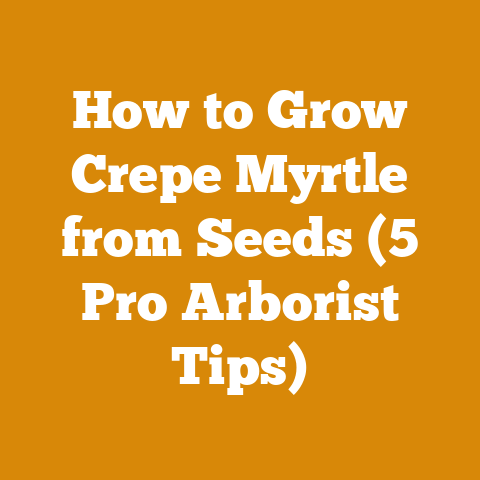How to Kill Pampas Grass Effectively (5 Proven Woodland Hacks)
Let’s face it, pampas grass can be a real headache if you’re trying to maintain a healthy woodland ecosystem.
It looks pretty, sure, but it spreads like wildfire and chokes out native plants.
Over the years, I’ve battled my fair share of invasive species in my own woodlot, and pampas grass consistently ranks high on the list of tough opponents.
That’s why I’ve compiled these 5 proven woodland hacks to help you effectively eliminate pampas grass and reclaim your land.
From targeted herbicide applications to good old-fashioned elbow grease, I’ll walk you through the best methods for tackling this invasive plant.
Hack #1: The Cut-and-Paint Herbicide Technique
This is often my go-to method for dealing with individual pampas grass clumps.
It’s precise, minimizes herbicide exposure to surrounding plants, and has a high success rate when done correctly.
Understanding the Cut-and-Paint Method
The cut-and-paint method involves cutting the pampas grass close to the ground and immediately applying herbicide to the freshly cut stems.
This allows the herbicide to be directly absorbed into the plant’s vascular system, effectively killing it from the roots up.
Timing is crucial; you want to apply the herbicide as quickly as possible after cutting to prevent the cut surface from drying out and hindering absorption.
Step-by-Step Guide to Cut-and-Paint
- Timing is Key: The best time to employ this method is during the growing season when the plant is actively transporting nutrients.
This is typically from late spring to early fall. Gather Your Supplies: You’ll need the following:
- Chainsaw or Brush Cutter: I prefer a chainsaw for larger clumps, as it makes quick work of the dense foliage.
For smaller clumps, a brush cutter or even a sturdy pair of loppers will suffice.
Ensure your chainsaw is properly maintained with a sharp chain.
I use a Stihl MS 271 FARM BOSS® for most of my woodland work. - Herbicide: Glyphosate-based herbicides are generally effective, but I recommend using a product specifically labeled for pampas grass control.
Triclopyr is another excellent option, especially if you’re dealing with woody plants in the area as well.
I’ve had good results with Roundup Custom Herbicide (glyphosate) and Garlon 4 Ultra (triclopyr).
Always follow the manufacturer’s instructions regarding concentration and application. - Applicator: A small paintbrush, a foam brush, or even a spray bottle with a narrow nozzle works well.
I prefer a small paintbrush for precision. - Personal Protective Equipment (PPE): This is non-negotiable.
Wear gloves, eye protection, long sleeves, and long pants to protect yourself from herbicide exposure and flying debris.
I always wear my Husqvarna Pro Forest Helmet System for head and face protection. - Prepare the Herbicide Solution: Mix the herbicide according to the manufacturer’s instructions.
Typically, you’ll be using a concentrated solution for the cut-and-paint method. - Cut the Pampas Grass: Using your chainsaw or brush cutter, cut the pampas grass as close to the ground as possible.
Aim for a clean, even cut. - Apply the Herbicide Immediately: Within seconds of cutting, apply the herbicide to the freshly cut stems.
Saturate the cut surface, ensuring the herbicide penetrates the plant’s vascular system. - Monitor and Repeat: Check the treated area periodically for regrowth.
If you see new shoots emerging, repeat the cut-and-paint process.
It may take several applications to completely kill the plant.
- Chainsaw or Brush Cutter: I prefer a chainsaw for larger clumps, as it makes quick work of the dense foliage.
Data and Insights
- Herbicide Concentration: Research suggests that a higher concentration of herbicide (e.g., 50% glyphosate solution) is more effective for the cut-and-paint method.
- Application Timing: Applying herbicide in the late afternoon or early evening, when the plant is actively drawing nutrients down to its roots, can improve efficacy.
- Regrowth Rates: In my experience, pampas grass treated with the cut-and-paint method typically shows a 70-80% kill rate with the initial application.
Follow-up treatments are usually necessary to eliminate any remaining regrowth.
Common Mistakes to Avoid
- Delaying Herbicide Application: As I mentioned earlier, timing is crucial.
Don’t wait to apply the herbicide after cutting. - Using Insufficient Herbicide: Make sure you saturate the cut surface thoroughly.
- Ignoring Regrowth: Be vigilant about monitoring the treated area and repeating the process as needed.
Real-World Example
I once had a particularly stubborn patch of pampas grass that had completely overtaken a section of my woodlot.
I tried mowing and pulling, but it just kept coming back.
Finally, I resorted to the cut-and-paint method, using a 50% glyphosate solution.
It took two applications, but I was eventually able to eradicate the pampas grass and restore the area to its natural state.
Takeaway
The cut-and-paint method is a highly effective way to control pampas grass, especially for individual clumps.
It’s precise, minimizes herbicide exposure, and has a high success rate when done correctly.
Hack #2: The Foliar Spray Method for Large Infestations
When you’re dealing with a large infestation of pampas grass, the cut-and-paint method can be time-consuming and impractical.
That’s where foliar spraying comes in.
This method involves spraying the entire plant with herbicide, allowing it to be absorbed through the leaves.
Understanding the Foliar Spray Method
The foliar spray method is best suited for large areas where pampas grass has become widespread.
It’s less precise than the cut-and-paint method, but it can be much more efficient for treating large infestations.
The key is to use the right herbicide, apply it at the correct concentration, and ensure thorough coverage of the plant’s foliage.
Step-by-Step Guide to Foliar Spraying
- Choose the Right Herbicide: Glyphosate and imazapyr are commonly used for foliar spraying of pampas grass.
Imazapyr has a longer residual effect, which can be beneficial for controlling regrowth, but it can also affect non-target plants.
Always read and follow the herbicide label carefully. Gather Your Equipment: You’ll need:
- Backpack Sprayer or ATV Sprayer: For large areas, a backpack sprayer can be exhausting.
An ATV sprayer with a boom or handheld wand is a much better option.
I use a Fimco 25-Gallon ATV Sprayer for larger projects. - Herbicide: As mentioned above, glyphosate or imazapyr are good choices.
- Surfactant: Adding a surfactant to the herbicide solution helps it stick to the plant’s leaves and improves absorption.
- Dye: A spray dye helps you see where you’ve already sprayed, preventing overlap and ensuring thorough coverage.
- PPE: Gloves, eye protection, long sleeves, long pants, and a respirator are essential.
- Prepare the Herbicide Solution: Mix the herbicide, surfactant, and dye according to the manufacturer’s instructions.
Be sure to use the correct concentration for foliar spraying. - Spray the Pampas Grass: Using your backpack sprayer or ATV sprayer, thoroughly spray the pampas grass foliage.
Aim for complete coverage, but avoid overspraying to the point of runoff. - Monitor and Repeat: Check the treated area periodically for regrowth.
You may need to repeat the spraying process to completely kill the pampas grass.
- Backpack Sprayer or ATV Sprayer: For large areas, a backpack sprayer can be exhausting.
Data and Insights
- Herbicide Coverage: Studies have shown that thorough herbicide coverage is essential for effective foliar spraying.
Aim for at least 80% coverage of the plant’s foliage. - Weather Conditions: Avoid spraying on windy days, as the herbicide can drift and affect non-target plants.
Also, avoid spraying before rain, as the herbicide may be washed off. - Growth Stage: Foliar spraying is most effective when the pampas grass is actively growing and has a large amount of foliage.
Common Mistakes to Avoid
- Using the Wrong Herbicide Concentration: Too little herbicide will be ineffective, while too much can damage non-target plants.
- Poor Coverage: Make sure you spray the entire plant, including the lower leaves.
- Ignoring Weather Conditions: As mentioned above, avoid spraying on windy or rainy days.
Real-World Example
I once helped a local landowner control a massive pampas grass infestation that had taken over several acres of pastureland.
We used an ATV sprayer with a glyphosate-based herbicide and a surfactant.
It took two applications, but we were able to significantly reduce the pampas grass population and allow native grasses to reestablish.
Takeaway
Foliar spraying is an efficient way to control large pampas grass infestations.
By using the right herbicide, applying it at the correct concentration, and ensuring thorough coverage, you can effectively eliminate this invasive plant and restore your land.
Hack #3: Smothering with Tarps or Mulch
This method is a non-chemical approach, relying on depriving the pampas grass of sunlight to kill it.
It’s a slower process, but it’s a good option for those who want to avoid using herbicides altogether.
Understanding the Smothering Method
The smothering method works by blocking sunlight from reaching the pampas grass, preventing it from photosynthesizing and eventually causing it to die.
This method is most effective when combined with other control techniques, such as cutting the pampas grass down to the ground first.
Step-by-Step Guide to Smothering
- Cut the Pampas Grass: Using a chainsaw or brush cutter, cut the pampas grass as close to the ground as possible.
Choose Your Smothering Material: You can use a variety of materials to smother the pampas grass, including:
- Black Plastic Tarps: These are durable and effective at blocking sunlight.
- Cardboard: This is a more environmentally friendly option, but it may break down over time.
- Thick Layer of Mulch: A thick layer of wood chips, straw, or other organic mulch can also smother the pampas grass.
- Cover the Pampas Grass: Cover the cut pampas grass with your chosen smothering material, making sure to extend the material several feet beyond the perimeter of the plant.
- Secure the Material: Weigh down the smothering material with rocks, bricks, or other heavy objects to prevent it from being blown away by the wind.
- Wait and Monitor: Leave the smothering material in place for at least six months, or even longer for larger plants.
Check periodically to make sure the material is still in place and that no new shoots are emerging. - Remove the Material: After the smothering period, remove the material and check for any remaining pampas grass.
If you see any new shoots, repeat the smothering process or use another control method.
Data and Insights
- Smothering Duration: Studies have shown that smothering for at least six months is necessary to effectively kill pampas grass.
- Material Thickness: The thicker the smothering material, the more effective it will be at blocking sunlight.
- Soil Temperature: Smothering can increase soil temperature, which can help to kill the pampas grass roots.
Common Mistakes to Avoid
- Using Too Little Material: Make sure you completely cover the pampas grass and extend the material beyond the perimeter of the plant.
- Not Securing the Material: The wind can easily blow away the smothering material, so make sure it’s securely anchored.
- Not Waiting Long Enough: Be patient and leave the smothering material in place for at least six months.
Real-World Example
I once used the smothering method to control a small patch of pampas grass that was growing near a sensitive wetland area.
I cut the pampas grass down to the ground and covered it with a thick layer of cardboard, which I then weighed down with rocks.
After six months, the pampas grass was completely dead, and I was able to remove the cardboard and replant the area with native vegetation.
Takeaway
Smothering is a non-chemical way to control pampas grass by depriving it of sunlight.
It’s a slower process, but it’s a good option for those who want to avoid using herbicides.
Hack #4: Prescribed Burning (Use with Extreme Caution!)
Prescribed burning can be an effective tool for controlling pampas grass, but it should only be used by trained professionals and under carefully controlled conditions.
Fire can damage or kill pampas grass by burning off the above-ground foliage and damaging the root system.
Understanding Prescribed Burning
Prescribed burning, also known as controlled burning, is the intentional use of fire to manage vegetation.
It’s a complex and potentially dangerous technique that requires specialized knowledge and equipment.
Prescribed burning can be used to control invasive species like pampas grass, reduce wildfire risk, and improve wildlife habitat.
Step-by-Step Guide to Prescribed Burning
Important: I am providing information about prescribed burning for informational purposes only.
Do not attempt to conduct a prescribed burn without proper training and permits. Prescribed burning should only be conducted by qualified professionals.
- Develop a Burn Plan: A burn plan is a detailed document that outlines the objectives of the burn, the location and size of the burn area, the weather conditions required for the burn, the resources needed for the burn, and the safety procedures to be followed.
- Obtain Permits: In most areas, you will need to obtain permits from local or state authorities before conducting a prescribed burn.
- Prepare the Burn Area: This involves creating firebreaks around the burn area to prevent the fire from spreading to unintended areas.
Firebreaks can be created by mowing, disking, or hand-clearing vegetation. - Conduct the Burn: The burn should be conducted under carefully controlled conditions, with trained personnel monitoring the fire and ensuring that it stays within the burn area.
- Monitor the Burn Area: After the burn, the burn area should be monitored for several days to ensure that the fire is completely extinguished and that there are no flare-ups.
Data and Insights
- Fire Intensity: The intensity of the fire is an important factor in controlling pampas grass.
A high-intensity fire is more likely to kill the plant, but it can also damage surrounding vegetation. - Timing of Burn: The timing of the burn can also affect its effectiveness.
Burning in the late winter or early spring, before the pampas grass begins to actively grow, can be more effective. - Post-Burn Management: After a prescribed burn, it’s important to monitor the burn area for regrowth and to implement other control methods as needed.
Common Mistakes to Avoid
- Conducting a Burn Without Proper Training: Prescribed burning is a complex and potentially dangerous technique that should only be conducted by qualified professionals.
- Ignoring Weather Conditions: The weather conditions must be within the parameters specified in the burn plan.
- Not Having Adequate Resources: You need to have enough personnel and equipment to safely conduct the burn.
Real-World Example
In some areas, prescribed burning is used to manage pampas grass in coastal grasslands.
The burns are conducted in the late winter or early spring, and they help to reduce the pampas grass population and promote the growth of native grasses and wildflowers.
Takeaway
Prescribed burning can be an effective tool for controlling pampas grass, but it should only be used by trained professionals and under carefully controlled conditions.
Hack #5: Manual Removal (Digging It Out)
For small infestations or in areas where you want to avoid using herbicides, manual removal – digging out the pampas grass – can be an effective option.
This is hard work, but it’s a satisfying way to get rid of this invasive plant.
Understanding Manual Removal
Manual removal involves physically digging up the pampas grass plant, including its root system.
This method is most effective for small infestations or individual plants.
It’s labor-intensive, but it’s a good option for those who want to avoid using herbicides or other chemical control methods.
Step-by-Step Guide to Manual Removal
Gather Your Tools: You’ll need:
- Shovel: A sturdy shovel with a sharp blade is essential for digging up the pampas grass.
- Pickaxe or Mattock: These tools can be helpful for breaking up hard soil and cutting through tough roots.
- Gloves: Protect your hands from blisters and cuts.
- Tarp or Wheelbarrow: Use these to transport the removed pampas grass.
- Prepare the Area: Clear away any debris or vegetation around the pampas grass plant.
- Dig Around the Plant: Start digging a circle around the plant, several feet away from the base.
Dig deep enough to reach the bottom of the root system. - Loosen the Roots: Use the pickaxe or mattock to loosen the roots from the soil.
Be careful not to break the roots, as this can make it harder to remove the plant. - Lift the Plant: Once the roots are loosened, carefully lift the plant out of the ground.
You may need to use the shovel to pry the plant out. - Dispose of the Plant: Place the removed pampas grass on a tarp or in a wheelbarrow and dispose of it properly.
Do not compost the plant, as it can re-root and spread.
The best way to dispose of it is to burn it or take it to a landfill. - Fill the Hole: Fill the hole with soil and compact it to prevent erosion.
Data and Insights
- Root Depth: Pampas grass roots can grow very deep, so it’s important to dig deep enough to remove the entire root system.
- Soil Type: Manual removal is easier in loose, sandy soils than in heavy clay soils.
- Plant Size: Smaller plants are easier to remove than larger plants.
Common Mistakes to Avoid
- Not Digging Deep Enough: Make sure you dig deep enough to remove the entire root system.
- Breaking the Roots: Be careful not to break the roots when digging, as this can make it harder to remove the plant.
- Not Disposing of the Plant Properly: Do not compost the plant, as it can re-root and spread.
Real-World Example
I once helped a friend remove a small patch of pampas grass from her garden.
We used shovels and pickaxes to dig up the plants, and it was hard work, but we were able to remove them completely.
We then filled the holes with soil and planted native flowers in their place.
Takeaway
Manual removal is an effective way to control pampas grass, especially for small infestations or in areas where you want to avoid using herbicides.
It’s hard work, but it’s a satisfying way to get rid of this invasive plant.
Conclusion: Reclaiming Your Woodland from Pampas Grass
Controlling pampas grass requires a persistent and strategic approach.
By understanding the plant’s biology and utilizing the appropriate control methods, you can effectively eliminate this invasive species and restore your woodland to its natural state.
Remember to always prioritize safety, follow herbicide labels carefully, and monitor treated areas for regrowth.
With dedication and the right tools, you can reclaim your land from pampas grass and create a healthier, more diverse ecosystem.






